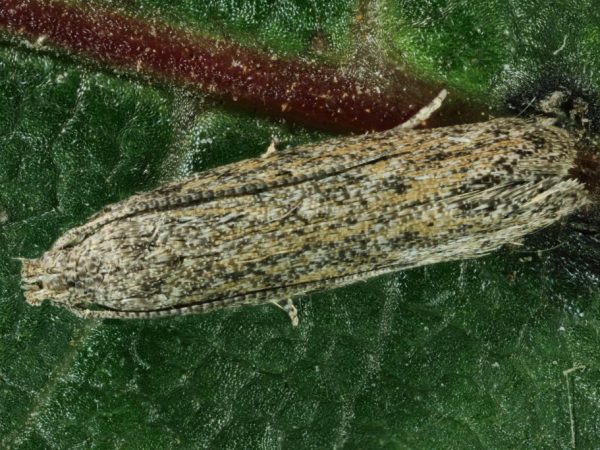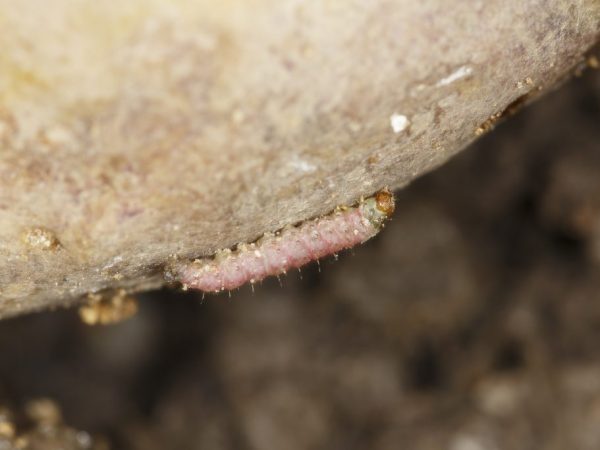Potato moth control methods
Potato moth, or, as it is also called, fluorimea, is capable of destroying almost the entire crop in just one season. Due to the scale of the harm it does, it can be compared to the potato's biggest enemy, the Colorado potato beetle. Probably, any farmer will be horrified when he sees a moth on a potato bush. Moreover, it can harm the crop more than once, because for a long time the parasite continues to live in weeds, tubers and even in the soil.

Potato moth control methods
It is important to know how to recognize the problem and start dealing with it in time in order to preserve the harvest as much as possible. So, what is a potato moth and how to deal with it, what needs to be done at the stage of growing and storage.
How to spot potato moth
The potato moth is small, but you can still see it. The parasite becomes active in the evening, during the day it is extremely difficult to detect it, since it will hide between the leaves of potatoes. To find a pest during the day, you need to slightly stir the leaves on the potato bushes, if there is a fluorimea infection, you will certainly see flying insects.
However, it is worth saying that this may not happen, in which case it is worth taking a closer look to see if there are insects on the leaves. In addition, you can see the passages that were gnawed by the potato moth, as well as the excrement that occurs in the process of life. Also, in the presence of such a parasite, you will probably find traces of cobwebs and rot on the leaves. However, direct evidence of the presence of fluorimea will be blackness and the presence of moth larvae in tubers. If such signs were found, it is worth immediately taking measures to combat fluorimea in order to save the future harvest.
What eats
At the beginning of its life cycle, that is, at the stage of the larva, fluorimea feeds on leaves, more precisely, on their lower part. When the tops dry out and the larva grows to the state of the larva, the insect tries to feed on the tubers, thus penetrating deeper into them, laying off new offspring of pests. In addition to potatoes, potato moth loves to feast on such products:
- Bell pepper
- Eggplant
- Tomatoes
- Nightshade plants
Despite the large amount of information about the dangers and methods of combating the parasite, many gardeners have no idea how to deal with it correctly, today we will try to shed light on solving this problem.
What is dangerous
As already mentioned, potato moth, first of all, is dangerous in that it affects the harvest at lightning speed, which can deprive you of potatoes in principle. In order for all the work done in the garden or field not to be in vain, you need to pay maximum attention to preventive measures, since they are much easier to carry out than fighting.
It is worth saying that the potato moth at the larval stage is considered no less dangerous, because at this stage of development, the potato moth can harm the potato at the stage of planting, ripening and even storage.Experienced gardeners say that the presence of a pest this year, unfortunately, will not give you the opportunity to harvest a good harvest even next year, it is so difficult to get rid of potato moths once and for all. In order to increase your chances in the fight against the parasite, it is worth taking measures immediately, because fluorimea is characterized as an extremely tenacious and prolific insect that survives at all stages, including during storage in storage.
Major harm
- Weakening of many crops due to destruction of the deciduous system
- Significant decrease in the quality and quantity of the crop
- Negative effect on the amount of seed
- Tomato and bell pepper bushes, which usually grow nearby, also suffer from fluorimea.
It so happens that in only one potato a farmer finds more than 10 larvae at different stages of development, of course, this vegetable cannot be called a potato, rather, it is a home for a potato moth, because there is practically no pulp left in it. Of course, in no case should you eat infected potatoes, it can cause poisoning, and such a vegetable looks extremely unattractive.
How to deal with moths

It is very difficult to deal with moths.
Before talking about effective methods of dealing with parasitic butterflies and how to deal with potato moths, you need to understand that the insect will be destroyed by itself if it does not have food. If you are faced with a massive defeat of the fields by fluorimea, then the best option would be to temporarily abandon planting nightshade crops and the potatoes themselves. If you are not ready to make such sacrifices, you will have to resort to the use of poisons. Unfortunately, today, despite the rapid development of agriculture, there is still no such means that could solve the problems of fluorimea damage once and for all, that is, no one can give you a 100% guarantee of the result.
With the help of the use of poisons and various means, you can significantly reduce the number of parasites, and also prevent the problem from becoming more global. It is worth saying that such an event must be carried out strictly before the first ovaries are formed.
Means to fight
We will find out which products have proven themselves in the best way:
- Preparations and tablets based on the bacteria Bacilius Thuringiensis, these are agents such as Letto, Entobacterin, Bitoxibacillin and Lepidocid. Potato bushes are treated with these means before the first ovaries are visible, otherwise all the points indicated in the instructions must be followed.This will help to reduce the number of larvae already hatched, ensure their partial death, and also reduce the fertility rate of adult females, mutate the development of potato moths on any of the stages, especially a drug such as Lepidocide;
- Methyl bromide. It is a bio-gas that is used as a pest control after the crop has been harvested, usually the fumigation method is chosen, since it has proven to be the most effective. Thanks to this treatment, up to 97% of the larvae that may be in the tubers at the time of harvest are destroyed;
- Traps for fluorimea. Special catching devices are capable of fighting both larvae and adult insects. However, they can be effective only if the defeat was not global, otherwise such a method of struggle is absolutely ineffective.
- There are also a lot of popular pseudo methods of dealing with fluorimea, but due to their practical uselessness, we will not talk about them.
Prophylaxis
As mentioned earlier, it is better to resort to preventive methods of dealing with fluorimea than to run the situation before a large-scale defeat by the pest. We will find out what preventive measures can be effective:
- An excellent prophylactic agent will be warming up potato tubers on the eve of planting, a suitable temperature of 40 degrees;
- Hilling culture, it is important to understand that this is necessary not only to make your beds look neat, but also in order to overcome all possible pests;
- When watering the crop, be careful not to show the tubers above the ground. If you organize by sprinkling irrigation, then with a high probability you will be able to protect the crop from being damaged by a pest and you will not have to process the tubers either before planting or during storage in storage facilities. By the way, it is necessary to store potatoes under the right conditions, usually, cellars, cellars and other suitable storage facilities are used for this;
- A well-organized crop rotation is the key to a good harvest. So, if you carefully select the tubers before planting, if a suitable depth is chosen for this, then with a high probability you will not face the problem of fluorimea damage, you will not have to treat the soil with poisons.
- Alternatively, you can switch to growing the earliest varieties of potatoes, since they turn out to be as resistant to damage by fluorimea as possible.
Conclusion
Now you know how to get rid of potato moths, what to do if a parasite has started in the culture. Finishing the story about the potato moth, it is worth saying once again that the defeat of fluorimea cannot go away on its own, over time the problem will only get worse and will cover more and more new territories. If this becomes a regional problem, local governments are required to take quarantine precautions that will veto the export of the crop outside the territory.
If you pay attention to how other countries are fighting the pest, you can find out that, for example, in South Africa it is customary to fight the parasite with the help of specially grown wasps that feed on fluorimea larvae. Unfortunately, this method of struggle can only be applied in the southern hemisphere, because wasps live only there. How to deal with potato moths in our latitudes was described in detail above.
In addition, there is the experience of countries where the import and export of potatoes outside the country is strictly controlled. For example, it is impossible to introduce potatoes to private individuals into Ukraine, and when a crop is imported to Australia, tubers must undergo a mandatory temperature warming up, in addition, they must be treated with an insecticidal cocktail. This again suggests that the problem is widespread throughout the world.


